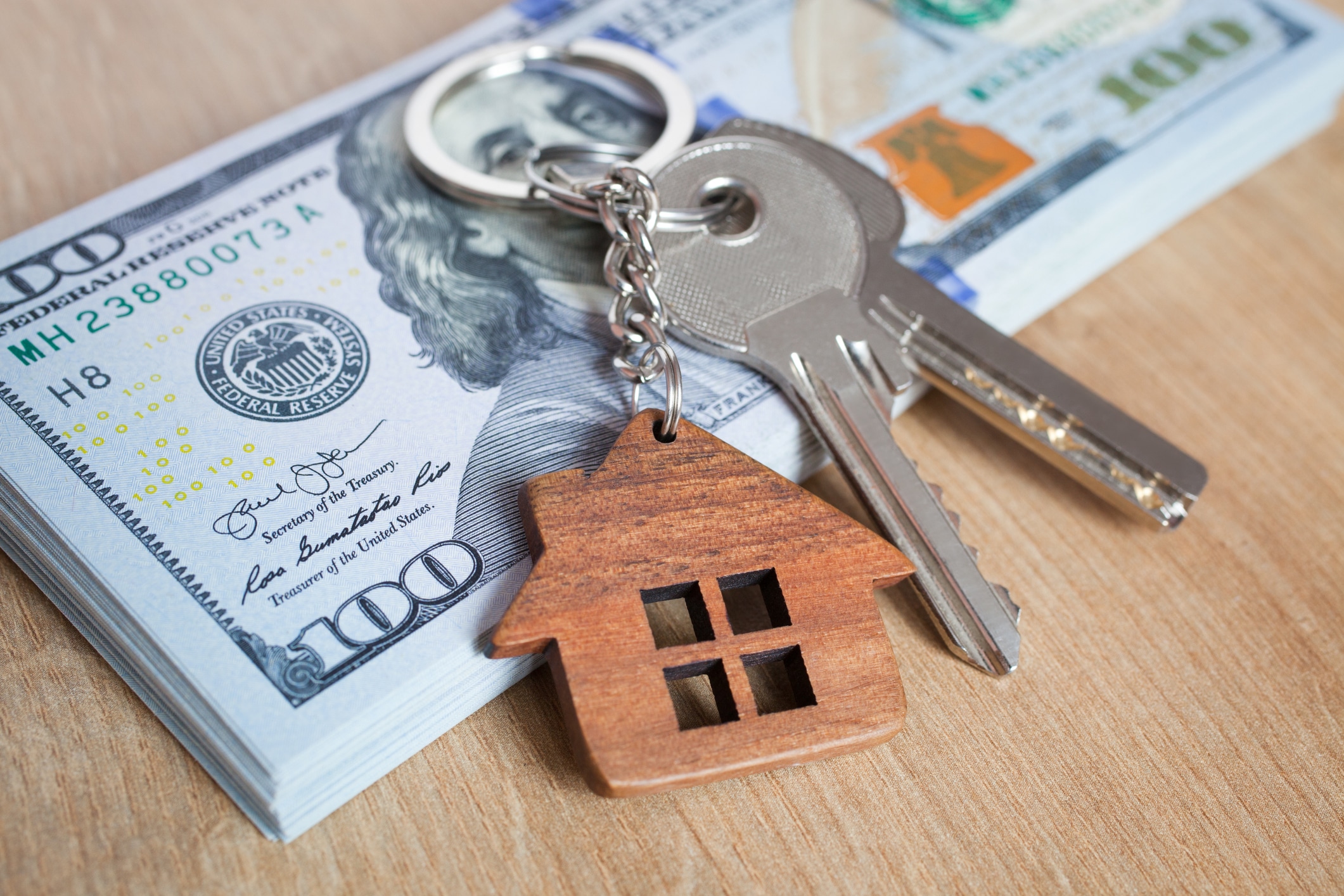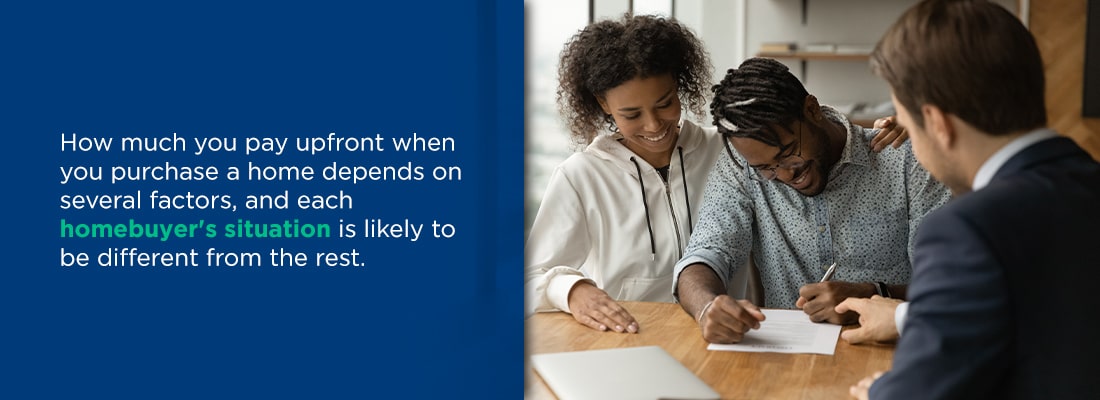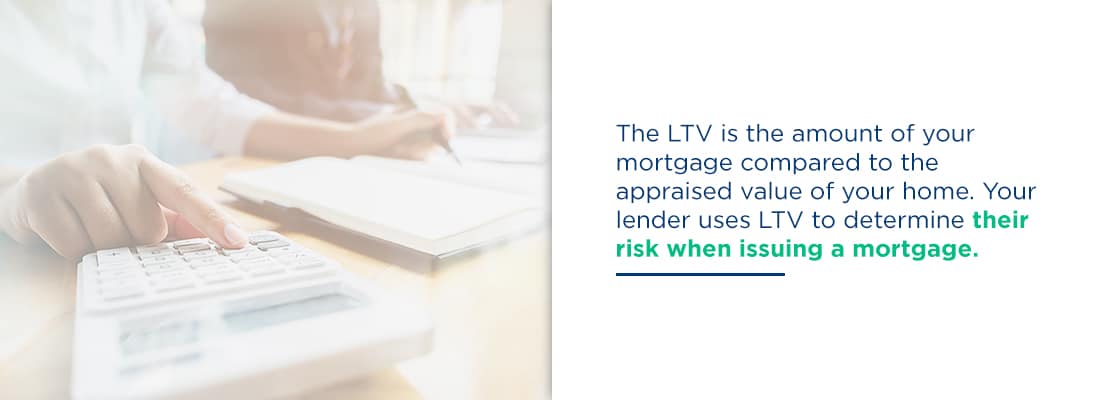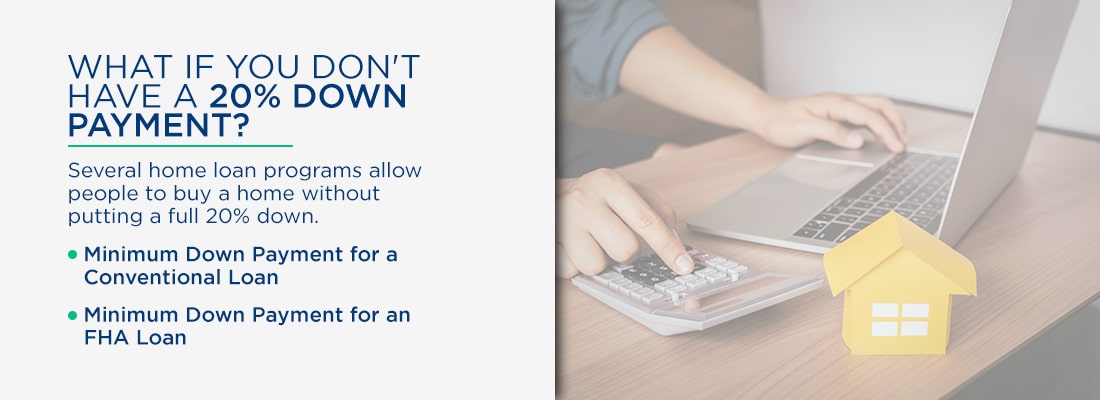When it comes to financing a home or a build, several factors are involved in the type of loan you apply for. The interest rate is a key factor, but the more important one is the down payment. A down payment on a home is the money you give to the lender initially. Typically, this is a piece of the overall cost of what is being borrowed. Whatever amount is left over after the down payment is paid must be paid off over time in the form of a mortgage.
Generally, a down payment is a percentage of the total cost being borrowed. It’s important to note that any down payment under 20% normally requires mortgage insurance. However, if you put down more than 20%, you don’t need insurance.
Table of Contents
- How Much is a Normal Down payment on a House?
- Pros and Cons of a 20% Down Payment
- What if You Don’t Have a 20% Down Payment?
- Can You Buy a House Without a Down Payment?
- How Does a Down Payment on a House Work?
- Apply for a Mortgage Today
How Much Is a Normal Down Payment on a House?
One of the most important things to learn when you’re going through the process of buying a home and applying for a mortgage is that there’s no such thing as “normal,” especially when it comes to the down payment. How much you pay upfront when you purchase a home depends on several factors, and each homebuyer’s situation is likely to be different from the rest.
Although 20% is often considered the “gold standard” down payment amount, the actual average is much lower. Depending on a person’s home buying status, the average amount people put down is around 6%. People buying their first homes usually make smaller down payments than repeat homebuyers.
There are a few things to consider when deciding how much you can afford to put down or how much you should put down when buying a home. One factor is what you can afford. Another is the housing market in your area. When it’s a seller’s market, meaning there is more demand for houses than homes available, a higher down payment will make you stand out as a buyer. In a buyer’s market, when there are more homes than demand, you can probably make a lower down payment and still get a good value on your mortgage.
It’s also worth considering how your down payment will influence the cost of your mortgage or the type of loans available to you. Your down payment has a direct impact on your mortgage’s loan-to-value ratio (LTV) and private mortgage insurance.
What Is a Loan-To-Value Ratio?
The LTV is the amount of your mortgage compared to the appraised value of your home. Your lender uses LTV to determine their risk when issuing a mortgage. The lower the LTV, the lower the perceived risk to the lender. For example, if you were to make a 20% down payment when buying a home, the LTV would be 80%. If you put down 40%, the LTV would drop to 60%. On the flip side, if you put down 10%, the LTV is 90%.
LTV affects risks in a few ways. First, the lower the LTV, the less money the lender will lose if borrowers default on their mortgage. If someone buys a $300,000 home and puts down 20%, the mortgage principal will be $240,000. But if that same borrower makes a 10% down payment, the principal amount increases to $270,000.
A higher LTV can be risky for a lender because there is a higher chance the borrower will default on the loan in general. When people can put down a large amount upfront, they signal a lender that they’re serious about homeownership and the commitment involved. With a smaller down payment, a borrower could seem less serious about their purchase.
Lenders can do a few things to make up for higher LTVs and the perceived higher risks. Often, when LTV is above 80%, a lender will charge a borrower a higher interest rate. Borrowers who put down less than 20% also usually have to purchase private mortgage insurance, paying a monthly premium in addition to their mortgage and interest payment.
LTV is important when you first buy a home, and it plays a role throughout your time as a homeowner. As you pay down the mortgage, the LTV drops, bit by bit. An increase in your home’s value can push LTV down, which can be good news for you as a borrower.
For example, when you purchased your home, it was appraised at $300,000. You borrowed $270,000 for an LTV of 90%. A few years later, your home is reappraised and its value is $350,000. You’ve also paid off $20,000 of your loan, pushing your principal balance down to $250,000. The LTV has dropped to 71%, meaning you could remove any mortgage insurance premiums. If you refinance, you might get a better interest rate, too.
Ideally, the LTV will steadily decrease during your time as a homeowner. In a perfect world, the value of your home would go up while the principal on your mortgage drops. That doesn’t always happen, though. If the value of your home drops, the LTV goes up. For example, after a couple of years, the value of your $300,000 home has fallen to $250,000. If you’ve paid $20,000 on your $270,000 mortgage, your LTV would be 100% since the house’s value is the same as what you owe on the home loan.
Making a larger down payment can help keep your home from going “underwater,” meaning you end up owing more on it than the house is worth.
What Is Private Mortgage Insurance?
Lenders typically expect buyers who put down less than 20% to pay private mortgage insurance (PMI) premiums. PMI gives the lender an extra layer of protection. If the borrower defaults or stops making payments as agreed, the insurance company reimburses the lender for the missed payments.
PMI can seem like an unnecessary added expense for a homebuyer, but sometimes, it’s the best option. If you don’t have enough saved to put down 20%, choosing a mortgage with PMI premiums and a smaller down payment can help you become a homeowner sooner rather than later. Your monthly PMI payment depends on the size of your mortgage and how much you’ve put down. The smaller the down payment, the larger the PMI.
On conventional mortgages, PMI premiums aren’t permanent. The lender will automatically remove them from your mortgage once the LTV falls to 78%. You can also request that the PMI be removed once your LTV has dropped to 80%.
What Are Closing Costs?
The down payment isn’t the only thing you need to pay upfront when you buy a home. You also need to pay closing costs or fees to your lender for getting a mortgage. Depending on how much you’ve saved, closing costs can affect how much you can afford to put down.
If you’ve saved $50,000 and want to buy a $250,000 home, you can put down a full 20%. You can put down $50,000 minus whatever your closing costs are. The cost of closing varies from location to location but is usually in the neighborhood of 3% to 6% of the purchase price of the home. Your lender can give you an estimate of your closing costs when you apply for a loan, which can give you a better idea of how much home and down payment you can afford.
[download_section]
Pros and Cons of a 20% Down Payment
While you don’t always have to put 20% down, there are definite benefits. There are also some drawbacks to making a large down payment, depending on your financial situation. Take a closer look at the pluses and minuses of paying a lot upfront.
Pros of 20% Down
Some reasons to put down 20% include:
- No PMI payment: When you put down at least 20% upfront, you don’t have to pay PMI premiums, which can help you save money on your monthly payment.
- Possibly lower interest rate: Buyers who put down more upfront look less risky to lenders, meaning you may get a lower interest rate on your mortgage. Paying less in interest saves you money each month and in the long run.
- You’ll look better to lenders and sellers: In a competitive market, sellers will be extra picky when considering offers because they can afford to be. They’re more likely to consider offers with bigger down payments than those with smaller ones. Lenders might be more attracted to buyers with bigger down payments, too, and might compete with other lenders to get your business.
- You’ll borrow less: The more you put down, the less you end up borrowing. That means a lower monthly payment. It can also mean that you can take out a loan with a shorter term, such as a 15-year mortgage instead of a 30-year. You’ll pay the loan off more quickly and will end up paying less overall.
Cons of 20% Down
A few reasons to consider a smaller down payment include:
- It can take a while to save up 20%: Unless you find an amazing deal on a home, 20% of the average purchase price is a considerable sum of money. If you’re looking for homes in the $250,000 to $300,000 range, you’ll need to save between $50,000 and $60,000, plus closing costs. If you can comfortably save $400 per month, it would take you over 12 years to save up $60,000. By that time, your housing needs might have changed and the price of homes might have gone up even more.
- It can make you “cash poor”: Even houses that look good upon inspection tend to throw a few surprises at their new owners. You buy a house and a month later, the refrigerator breaks, or there’s a leak in the plumbing. It’s a good idea to have some cash leftover in savings to cover any unexpected home-related expenses. If you sink all of your money into a down payment, you won’t have enough left for emergencies.
- You can lose money if your home value drops: As a general rule, property values tend to increase over time. But there is a chance that the value of your home will fall. If you put 20% down and the value of your home drops by 30%, you’ve lost money. You’re also likely to see a smaller return on investment if you make a big down payment and your property value increases.
What if You Don’t Have a 20% Down Payment?
If you don’t have 20% to put down on your home purchase, don’t worry. You’re in the same boat as plenty of other homebuyers. Several home loan programs allow people to buy a home without putting a full 20% down.
Minimum Down Payment for a Conventional Loan
At the height of the housing boom in the early 21st century, borrowers could easily get conventional mortgages with small or no down payments. The housing crisis brought those days to a grinding halt, and for a while, 20% down was the way to go for a conventional loan.
But as time has marched on and the housing market has recovered, down payment requirements have become somewhat looser. As long as you meet the lender’s requirements for income, credit, and employment history, and you agree to pay PMI, you can take out a conventional mortgage with a 5% or 10% down payment.
If you don’t have 5% to put down, there is an option to get a conventional loan with 3% down, meaning the LTV is 97%. Mortgages with 97% LTVs typically have income limits for borrowers. They also require higher PMI premiums. Borrowers usually need to complete homebuyer education programs, too.
Minimum Down Payment for an FHA Loan
Another mortgage option for people who can’t put 20% down is the FHA loan program. The FHA mortgage program started in the 1930s to help more Americans afford homeownership. To facilitate buying a home, it allows people to put down 3.5%. People who have credit scores that would make it more challenging to get a conventional loan can often qualify for an FHA loan.
FHA loans allow for smaller down payments for a couple of reasons. First, they are guaranteed by the Federal Housing Administration, a government agency. If a borrower stops making payments on the mortgage, the FHA has the lender’s back.
Second, borrowers need to pay for mortgage insurance when they take out an FHA loan. They get charged a premium upfront at the time of closing and need to pay a monthly premium. Depending on when a borrower took out their FHA loan, the premium is usually for the life of the mortgage.
The mortgage insurance on an FHA loan makes it possible for someone who can’t afford a large down payment to buy a home today and makes the home more expensive in the long run. If you have the credit to qualify for a conventional loan, that might be a more affordable option than an FHA loan.
Can You Buy a House Without a Down Payment?
If you don’t have much money available to make a down payment on a home, you might still qualify for a mortgage. Some mortgage programs allow for financing of up to 100% of the home’s value. Whether buying a home without a down payment is a good idea or not depends on your financial circumstances and whether you qualify for a special mortgage program.
VA Loans
VA loans let active duty service members and veterans purchase homes without a down payment. To qualify for a VA loan, you need to obtain a certificate of eligibility that verifies that you meet the requirements.
Along with allowing people to buy a home with no money down, the VA loan program also makes homeownership more affordable. Unlike other loan programs, there is no mortgage insurance associated with a VA loan. Closing costs also tend to be lower for VA loans than other loan options. If a borrower is having trouble repaying their loan, the VA offers support and assistance.
Credit requirements can be looser for a VA loan than they are for conventional mortgages. You might qualify for a VA loan with a credit score as low as 620. Exact credit requirements vary from lender to lender, and the VA itself doesn’t set any minimums.
USDA Loans
If you’re interested in buying a home in a more rural area and meet certain income requirements, a USDA loan can be an option. Like VA loans, USDA loans allow for up to 100% financing. The loans come from private lenders but are backed by the U.S. Department of Agriculture. The goal of the USDA loan program is to help people who would otherwise have limited housing options find a clean and safe place to live.
USDA loans do charge a monthly mortgage insurance premium to borrowers. Like the FHA loan program, borrowers need to pay an upfront mortgage insurance premium and a monthly premium when they take out a USDA loan.
If a borrower has trouble repaying their USDA loan, the government agency can step in. The USDA guarantees 90% of the loan value, meaning it will reimburse the mortgage lender for any losses, up to 90% of the principal, if a borrower stops making payments.
Other Options
While government-sponsored loans are really the only 0% down options available today, there are other programs available to buyers who might have trouble coming up with a down payment. Your state or city might have first-time homebuyer programs that pay for a portion of your down payment. It’s worth looking around to see what options are available to you to make buying your home more feasible.
How Does a Down Payment on a House Work?
The down payment on your home affects your mortgage in several ways:
- How much you borrow: The bigger your down payment, usually the less you end up having to borrow, which can mean you can afford a shorter mortgage term.
- How much you pay monthly: The smaller your mortgage, the lower your monthly payments of principal and interest. You can have more wiggle room in your budget and might be able to save up for other financial goals.
- How much interest you pay: Bigger down payments equal lower risk in the eyes of lenders, which could mean a lower interest rate, too.
- How much home you can afford: If you have a hefty down payment saved, you might be able to afford a more expensive home than someone with a smaller down payment.
Apply for a Mortgage With Assurance Financial Today
When deciding how much to put down on your home, there’s no one right answer. A smaller down payment might be right for one homebuyer and a bigger down payment right for another. If you’re curious about your down payment options and want to learn more about the various mortgage options available, Assurance Financial can help. You can start your mortgage application with us online in just minutes. Apply today to get on the path toward homeownership.
Linked Sources:
- https://www.consumerfinance.gov/ask-cfpb/when-can-i-remove-private-mortgage-insurance-pmi-from-my-loan-en-202/
- https://assurancemortgage.com/conventional-loans/
- https://assurancemortgage.com/fha-loans/
- https://assurancemortgage.com/va-loans/
- https://assurancemortgage.com/5-things-know-va-loans/
- https://assurancemortgage.com/usda-loans/
- https://assurancemortgage.com/apply/










